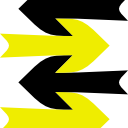
Ambidexter tutorial
lesson 1
and types, function types, True
email Scott Turner
introduction
This is a lesson in Logic and Programming. Both of these fields of study originated in the first part of the 20th century, but the close relationship between proofs and programs was not well known or understood. The understanding has arrived in the last 10 to 20 years. However, most people familiar with both programming languages and logic are still unaware of the connection.
There is a deep relationship between the two which Curry, Howard, and de Bruijn elucidated.
(In about 1969 I took a course in formal logic from the philosophy
department at Harvard. It taught a system of logic called Natural
Deduction, developed by Gentzen in the 1930's. I had already done
some computer programming, but was away from it until 1973 and I
really got back to it in 1976. At that time Pascal was an up and
coming language, and it was a big deal when the inventor of Pascal
came up with a new language with modules to support abstraction,
Modula. In the early 80's Ada was developed with modules and
generics. A few years later, at about the time when object-oriented
languages were becoming popular due to their support for abstraction,
in 1988 a paper titled Abstract types have existential type
appeared in a journal that I was receiving which made
Natural Deduction into a programming language. It did so in a
straightforward way. It had abstraction and generics, and achieved
this effortlessly and without imposing limitations on the way its
constructs could be combined. I was astonished. People (myself
included) had been spending much effort toward
these goals of programming language design
when an excellent framework for solution had been staring them in the
face all this time.)
examples
The following programs contain commentary that provides an introduction to a few aspects of logic, types, and the Ambidexter language. Covered are trivial proofs/types of True and False, as well as building larger proofs using "and" and "implies". The introduction is not thorough, so is recommended for those with some experience programming in a statically-typed language such as C or Java.exercise
- Write a program which uses a type different from any of those in the example programs.